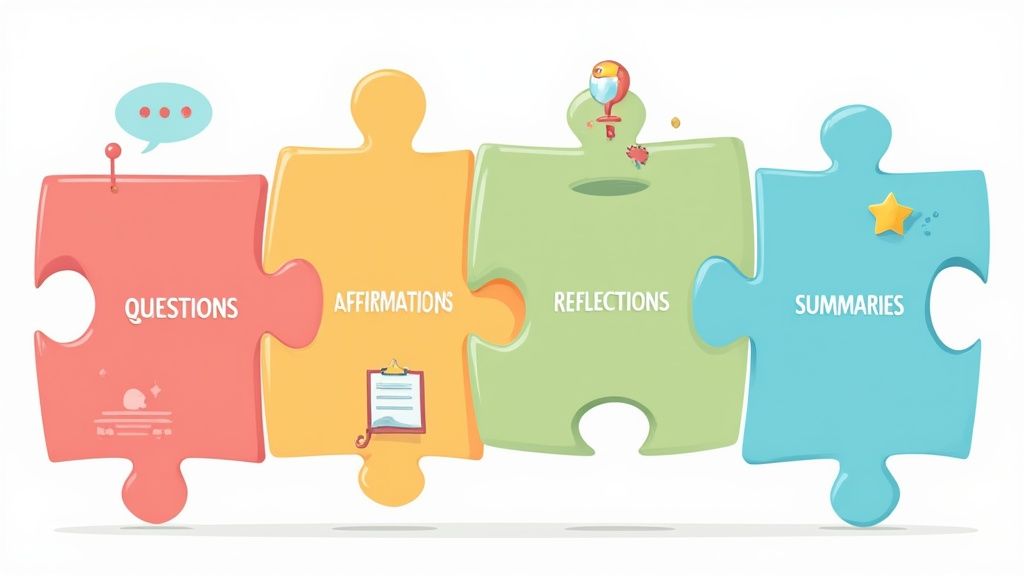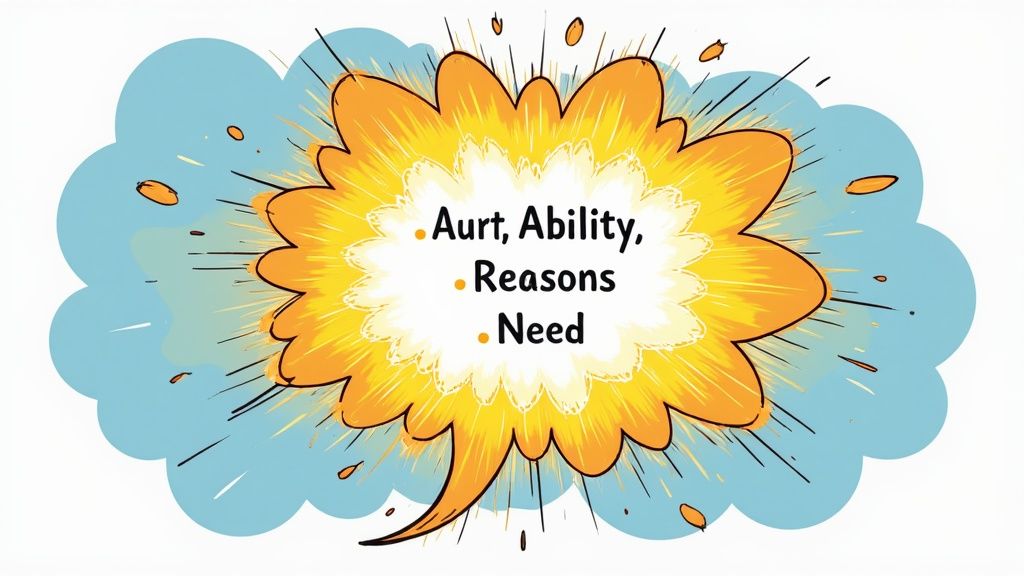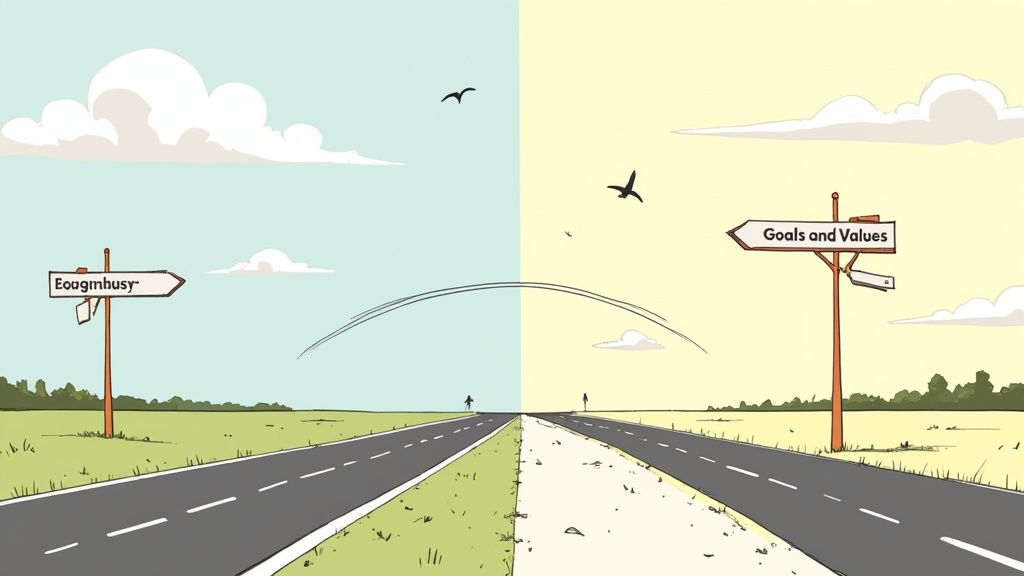8 Motivational Interviewing Techniques to Empower Change


Unlocking the Power of Conversations
Have you ever wondered what makes someone truly want to change? While there's no magic formula, motivational interviewing (MI) offers proven techniques that can help unlock inner motivation. This method, which emerged from addiction therapy and counseling in the 1980s, has grown into an evidence-backed approach for supporting positive change. Unlike traditional advice-giving, MI focuses on drawing out a person's own reasons and capacity for growth.
The power of MI lies in its understanding that feeling uncertain about change is perfectly normal. By exploring this uncertainty together in a respectful way, people often discover their own path forward. The collaborative spirit of MI creates a trusting environment where self-discovery can flourish. When someone feels truly heard and understood, they become more open to exploring possibilities for change.
Whether you're a coach, someone passionate about personal development, or simply looking to have more meaningful conversations, this article will explore the core ideas behind motivational interviewing. You'll learn practical strategies for having empowering discussions that help bring out the best in yourself and others. Get ready to discover how thoughtful conversations can spark real transformation.
1. OARS (Open Questions, Affirmations, Reflections, Summaries)

OARS stands for Open Questions, Affirmations, Reflections, and Summaries - the core communication tools used in motivational interviewing. This framework helps coaches create meaningful conversations that guide clients toward positive change. Its effectiveness and versatility have made it a fundamental approach in coaching and personal development.
Key Components of OARS:
The framework creates a supportive environment where clients can explore their own motivations rather than being told what to do. Here's how each element works:
Open Questions: These encourage detailed responses beyond yes/no answers. For example: "What makes you interested in making this change?" or "How would you approach this situation differently?"
Affirmations: Brief statements that recognize client strengths and efforts. Examples: "You've shown real commitment by taking this step" or "I notice how thoughtfully you've considered your options."
Reflections: The core skill of mirroring back what clients say while capturing deeper meaning. Simple reflections restate content, while complex ones explore underlying emotions. Example - Client: "I want to exercise but never find the time." Coach: "It sounds like you're feeling stuck between your health goals and daily demands."
Summaries: Brief recaps that tie together key discussion points and check understanding. They help track progress and transition between topics.
Real-Life Application:
Consider someone working to build better eating habits. A coach using OARS might ask "What benefits would you like to see from changing your diet?" (Open Question). After listening, they could note "You've already made positive changes by planning your meals" (Affirmation). They might reflect "It seems like stress really impacts your food choices" (Reflection). Finally, they could summarize: "We've discussed your goals for more energy and better health, plus some challenges around evening snacking. Would you like to explore some specific strategies?" (Summary).
Origins and Impact:
William Miller and Stephen Rollnick created OARS as part of their work on motivational interviewing. Research shows it works well across many settings - from health coaching to career development - because it respects client autonomy while promoting change.
Tips for Using OARS:
- Begin with basic open questions before moving to more complex ones
- Practice reflection skills regularly - they take time to develop
- Keep summaries focused on the most relevant points
- Make affirmations specific and authentic
Benefits and Limitations:
Advantages:
- Builds strong client relationships
- Makes clients feel understood
- Works well in many situations
- Reduces defensiveness
Challenges:
- Requires practice to use naturally
- Takes time to master
- May feel awkward at first
OARS gives coaches a clear framework for having productive conversations that help clients discover their own path to change. With practice, these skills become natural tools for supporting client growth.
2. Change Talk Elicitation

Change Talk Elicitation is a key technique in motivational interviewing (MI). It involves having meaningful conversations that help people find their own reasons and motivation to make changes, rather than being told what to do. When people discover their own drive to change, they're much more likely to stick with it compared to following someone else's advice.
The DARN-CAT Framework helps identify different types of change talk:
- Desire: "I want to eat healthier foods"
- Ability: "I could start exercising twice a week"
- Reasons: "Better eating would give me more energy"
- Need: "I need to quit smoking for my health"
- Commitment: "I will walk every morning"
- Activation: "I'm ready to see a nutritionist"
- Taking Steps: "I started packing lunch instead of eating out"
Effective Questions to Encourage Change Talk:
As a coach, asking thoughtful questions helps clients explore their own perspective. Some examples:
- "What positive changes would you see if you made this shift?"
- "What are the pros and cons of keeping things the same?"
- "On a scale of 1-10, how sure are you that you can make this change?"
- "Tell me about a time you successfully made a similar change before"
- "What do you hope will be different in the future?"
Background and Development:
This approach emerged from William R. Miller and Stephen Rollnick's work in addiction treatment. They found that confronting clients about substance use often backfired, while empathy and collaboration helped people find their own path to change. The method has since spread to healthcare, coaching, education and beyond.
Real-World Example:
Consider a weight loss coaching session. Instead of prescribing a diet plan, the coach asks "What makes you want to lose weight?" The client might say "I want more energy to play with my kids" and "I'm concerned about my health." These responses show personal reasons and needs. Following up with "How would more energy change your daily life?" helps the client build their own case for change.
Key Benefits:
- Builds internal motivation
- Reduces defensive reactions
- Strengthens commitment
Potential Challenges:
- Takes practice to spot opportunities
- Requires patient listening
- May not work with highly resistant people
Tips for Success:
- Listen carefully for change talk and explore it further through reflection
- Use rating scales to assess readiness and identify confidence levels
- Don't force the conversation - let clients work through uncertainty at their pace
By developing Change Talk Elicitation skills, coaches can help clients take ownership of their growth journey and make lasting positive changes.
3. Rolling with Resistance
Rolling with resistance is a key concept in motivational interviewing (MI). This method works with a client's reluctance to change rather than fighting against it. The approach recognizes that having mixed feelings about change is perfectly normal and shouldn't be argued away. By working collaboratively instead of confrontationally, counselors can better understand their clients' perspectives while building stronger relationships.
Why This Matters: When clients show resistance, it often means they don't feel heard or feel too pressured. Using this technique helps reduce tension and creates a more open environment for real discussion. This makes it one of the most important tools in motivational interviewing.
Key Features and Benefits:
- Non-confrontational Style: Keeps clients engaged by validating their viewpoint rather than challenging it directly
- Resistance as Feedback: Views resistance as helpful information about the client's concerns and barriers, not as an obstacle
- Engagement Techniques: Uses methods like reflective listening and respecting autonomy to keep clients involved even when they express doubts
Advantages:
- Less Defensiveness: Accepting resistance helps clients feel more comfortable exploring their mixed feelings
- Better Relationships: The collaborative, judgment-free approach builds trust between counselor and client
- More Engagement: When clients feel understood, they're more likely to stay involved even during difficult moments
Challenges:
- Feels Unnatural: Some practitioners find it hard not to directly challenge resistance, especially if they're used to more directive methods
- Takes Time: This approach may not show quick visible results since it focuses on building internal motivation
- Requires Patience: Working effectively with resistance means being comfortable with slow progress and client uncertainty
Real Examples:
Client: "I know exercise would help, but I just can't find the time."
Counselor: "Finding time for exercise feels impossible with everything else on your plate."
Client: "Quitting drinking would hurt my social life."
Counselor: "You're worried about how stopping drinking might change your friendships."
These examples show how counselors can mirror resistance back while validating concerns.
Practical Tips:
- Don't Push for Change: Focus on understanding the client's view instead of selling them on change
- Use Simple Reflections: Echo back the client's feelings and concerns to show you hear them
- Highlight Personal Choice: Remind clients that they control their own decisions
- Make Two-Sided Reflections: Acknowledge both sides - like "You want to eat better, but you also really value quick convenient meals."
Background and Growth:
The concept emerged from the work of William R. Miller and Stephen Rollnick as they developed motivational interviewing. Research keeps showing how well MI works for behavior change in many areas, from addiction to health improvement. The supportive nature of rolling with resistance fits well with modern client-centered approaches to coaching and therapy.
4. Developing Discrepancy
Developing Discrepancy is a core technique in motivational interviewing that helps people recognize gaps between their current behaviors and their values and goals. When people become aware of these gaps, it creates a natural drive for change from within rather than relying on outside pressure.

The technique emerged when the founders of motivational interviewing noticed that directly confronting people about problematic behaviors often backfired. They found that helping people explore disconnects on their own led to greater ownership of the change process.
Key Elements of Developing Discrepancy:
- Values Work: Help clients identify what truly matters to them through tools like values card sorting exercises
- Behavior Analysis: Guide clients in examining how their actions align with their core values and goals
- Future Vision: Support clients in imagining their future both with and without making desired changes
Benefits:
- Internal Drive: Changes driven by personal values tend to stick better than external pressure
- Meaningful Connection: Links desired changes directly to what matters most to the client
- Natural Motivation: Recognizing gaps between values and actions naturally spurs desire for change
Challenges:
- Emotional Weight: Facing inner conflicts can feel uncomfortable for clients
- Need for Skill: Requires careful, empathetic guidance to avoid triggering defenses
- Risk of Resistance: Can backfire if the client feels judged or pushed
Real-World Examples:
- A parent who values quality family time but spends evenings on social media can explore this disconnect to find motivation for changing screen habits
- Someone who prioritizes health but continues smoking can examine how this behavior clashes with their wellness goals
- A client can reflect on how drinking impacts their stated value of being a good parent
Practice Tips:
- Use Visual Tools: Values cards provide a concrete way to identify priorities
- Paint Pictures: Help clients vividly imagine different future scenarios
- Ask, Don't Tell: Guide clients to discover gaps themselves through thoughtful questions
- Stay Supportive: Create a judgment-free space for exploring inner conflicts
This technique deserves attention because it taps into natural human motivation. When used skillfully, it helps people connect with their own reasons for change rather than relying on external pressure or advice.
5. Agenda Mapping
Agenda mapping is a powerful tool in motivational interviewing where practitioners and clients work together to identify and prioritize discussion topics. This approach helps keep sessions focused while giving clients an active role in guiding conversations, making it an essential method for coaches and counselors who want to lead productive sessions.
When using agenda mapping, both parties shape the discussion path together rather than having the practitioner dictate the flow. This builds trust and helps clients take ownership of their progress. Think of it as creating a shared roadmap for each session.
Features of Agenda Mapping:
- Visual tools: Using whiteboards, paper, or other visual aids makes topics more concrete and easier to organize. Visual representation helps with setting clear priorities.
- Joint priority-setting: Clients take an active role in choosing which topics matter most. This shared approach increases their engagement and commitment.
- Balanced structure: While agenda mapping provides organization, it stays adaptable. New topics can be incorporated as they naturally arise.
Pros:
- Clear focus: Having an established agenda helps both parties stay on track and avoid scattered discussions.
- Client-centered: Putting client priorities first supports their independence and ensures their key concerns are addressed.
- Better time use: Working from an agreed agenda helps make the most of each session.
Cons:
- Initial time investment: Creating the agenda takes time from the main discussion.
- Needs updating: As conversations develop, the original agenda often needs adjusting.
- Requires planning: Practitioners must prepare to guide the agenda-setting process effectively.
Tips for Implementation:
- Keep visuals basic: Use simple lists or mind maps instead of complex diagrams.
- Stay concise: Focus on key topics rather than detailed plans.
- Check progress: Regularly confirm the agenda still matches client needs.
- Stay open: Welcome new topics that come up naturally during discussion.
Popularized By: Stephen Rollnick, who helped develop motivational interviewing and promote agenda mapping as a core technique.
Real-World Example:
A coach works with a client on time management skills. Through agenda mapping, they identify several topics: task prioritization, reducing procrastination, getting organized, and goal setting. The client then selects "reducing procrastination" and "goal setting" as their main focus areas. This helps the coach target the session on what matters most to the client.
Why Agenda Mapping Matters:
Agenda mapping reflects the key principles of motivational interviewing - working together, respecting client choices, and building engagement. By providing clear structure while staying flexible, it creates an effective framework for meaningful conversations that lead to positive change. The technique helps clients feel understood and valued, which leads to better outcomes.
6. Importance and Confidence Rulers
The Importance and Confidence Rulers are practical tools used in motivational interviewing (MI) that help clients explore their readiness for change. These straightforward numerical scales from 0-10 allow people to quickly rate both how important a change feels to them and how confident they are about making it happen.
Understanding the Scales
The Importance Ruler asks "How important is making this change to you?" with 0 meaning not at all important and 10 being extremely important. The Confidence Ruler explores self-belief with "How confident are you that you could make this change if you decided to?" rated from 0 (no confidence) to 10 (complete confidence).
How to Use the Rulers Effectively
The real value comes from the discussion that follows the initial rating. Key follow-up questions include:
- "What made you choose a 6 instead of a lower number?"
- "What would need to shift for you to move up to a 7?"
- "What gives you that level of confidence?"
- "What resources would help increase your confidence?"
These questions help uncover barriers, strengths, and next steps in a natural way.
Example in Practice
Consider Sarah, who wants to quit smoking. She rates importance at 7 (driven by health concerns) but confidence at 4 (due to past failed attempts). This helps her coach focus on building confidence through identifying triggers and developing new coping strategies.
Key Tips for Implementation:
- Use visual aids like printed rulers to make the concept tangible
- Track ratings over time to show progress
- Focus heavily on building confidence, as this predicts success
- Accept all ratings without judgment - the goal is understanding
Benefits of Using the Rulers:
- Simple to understand and use
- Creates measurable data points
- Opens up meaningful discussions
- Helps identify specific areas for growth
Potential Limitations:
- May oversimplify complex situations
- Ratings can vary based on mood/circumstances
- Requires skilled follow-up to be most helpful
Why These Tools Matter
The Importance and Confidence Rulers give structure to exploring motivation and capability for change. By separating the "why" from the "how," they help both coach and client focus their efforts where needed most. Their accessibility and flexibility make them invaluable for facilitating productive conversations about behavior change.
7. Decisional Balance
Decisional Balance is a practical technique used in motivational interviewing (MI) that helps people explore mixed feelings about making changes. By examining the benefits and drawbacks of both staying the same and changing behavior, people can better understand their true motivations and make thoughtful choices that align with their values.
Understanding the Concept
The process uses a four-part framework that includes:
- Benefits of Current Behavior: Looking at what works about keeping things as they are. For example, a person who smokes might value the stress relief and social connections.
- Costs of Current Behavior: Examining what's not working with the present situation, like health risks, money spent, and impact on family relationships.
- Benefits of Making Changes: Exploring potential gains from new behaviors, such as better health, financial savings, and being a positive role model.
- Costs of Making Changes: Acknowledging real challenges of changing, like managing withdrawal, social pressures, or fear of failure.
Growth and Development
This approach emerged from cognitive therapy and became a key part of MI as research showed how important it is to work through ambivalence about change. Early studies in addiction treatment highlighted why understanding mixed feelings matters, making Decisional Balance a trusted tool for supporting personal growth.
Real Examples in Practice
Here's how it might work with someone struggling with procrastination:
- Benefits of Current Pattern: Quick stress relief, avoiding hard tasks, immediate comfort
- Costs of Current Pattern: Last-minute panic, lost chances, poor results
- Benefits of New Approach: Better time use, less stress, more productivity, greater confidence
- Costs of New Approach: Takes work and discipline, facing uncomfortable tasks, learning from mistakes
Another example is someone thinking about changing careers - weighing staying in a stable but unfulfilling job versus pursuing more challenging but potentially rewarding work.
Key Elements and Trade-offs:
- Core Features: Four-part exploration, balanced review of options, written or verbal formats
- Main Benefits: Complete picture, reduces black-and-white thinking, respects uncertainty
- Strengths: Builds self-knowledge, supports personal choice, identifies obstacles and motivators
- Limitations: Takes time, may increase uncertainty initially, needs skilled guidance
Tips for Using This Approach:
- Start with Current Benefits: This builds trust and shows you understand their perspective
- Write Things Down: Visual aids can make ideas clearer
- Cover All Areas: Give fair attention to each part of the discussion
- Notice Common Threads: Look for repeated themes in motivations and barriers
- Don't Force Change: Focus on exploration rather than pushing for specific outcomes
Why This Tool Matters
Decisional Balance stands out because it directly addresses the challenge of mixed feelings about change. The structured approach helps people fully explore their situation and make choices that work for them, leading to more successful and lasting changes. This makes it essential for coaches and anyone interested in personal development.
8. Looking Forward

The Looking Forward technique helps people explore and visualize potential future outcomes to build motivation for change. By examining both positive and negative scenarios, clients gain deeper insights into how their current choices affect their future. This approach connects people with their personal reasons for making changes, rather than relying on external pressure.
When clients imagine themselves achieving their goals, it creates a powerful emotional connection to their desired outcome. The visualization process helps clarify goals and strengthens commitment to taking action. Looking Forward bridges the critical gap between wanting to change and actually making it happen.
Key Elements:
- Guided future visualization exercises with specific timeframes
- In-depth exploration of both positive outcomes and consequences of inaction
- Goal-setting that feels personally meaningful and achievable
This method draws from positive psychology and cognitive behavioral therapy principles about how thoughts influence behavior. Rather than telling clients what to do, Looking Forward helps them discover their own compelling reasons for change.
Real-World Application: Consider a health coach working with someone who wants to quit smoking. Instead of listing health risks, the coach asks: "Picture yourself 5 years from now as a non-smoker. What does your typical day look like? How do you feel physically? How are your relationships?" Then explores the contrast: "Now imagine 5 years continuing to smoke. What's different?" This helps the client emotionally connect with future possibilities.
Benefits:
- Creates genuine optimism about change being possible
- Taps into personal values and internal motivation
- Makes abstract goals more concrete and actionable
Potential Challenges:
- Some clients struggle with abstract visualization
- Requires engagement with imagination
- May trigger anxiety about negative futures for some people
Best Practices for Implementation:
- Use concrete timeframes like 1 year or 5 years ahead
- Include vivid sensory details in visualizations
- Balance optimism with realistic expectations
- Connect future vision to specific present-day actions
Remember to adapt the technique based on each client's comfort level with visualization. While some people naturally connect with detailed future scenarios, others may need a gentler approach focused on shorter timeframes or simpler outcomes.
8-Point Motivational Interviewing Techniques Comparison
| Technique | Complexity 🔄 | Expected Outcomes 📊 | Ideal Use Cases | Key Advantages ⭐ |
|---|---|---|---|---|
| OARS (Open Questions, Affirmations, Reflections, Summaries) | Moderate – requires practice and authenticity | Build rapport, foster client self-discovery | Motivational interviewing and diverse conversational contexts | Versatile; strengthens therapeutic alliance |
| Change Talk Elicitation | Moderately High – needs careful cue recognition | Draws out self-motivating statements | Enhancing client commitment and reducing defensiveness | Boosts internal motivation |
| Rolling with Resistance | High – demands skilled, patient navigation | Maintains engagement; minimizes confrontation | Situations with client ambivalence or resistance | Preserves the therapeutic relationship |
| Developing Discrepancy | High – requires skilled facilitation | Highlights gaps between behavior and values | Clients needing insight into value-behavior gaps | Catalyzes change through value connection |
| Agenda Mapping | Low to Moderate – structured yet flexible | Provides clear focus and session direction | Collaborative session planning and priority setting | Enhances efficiency and clarity |
| Importance and Confidence Rulers | Low – simple numerical scaling | Offers concrete measures of change importance | Quick assessments and progress tracking | Easy to use; promotes focused discussion |
| Decisional Balance | Moderate – requires balanced facilitation | Explores pros and cons; clarifies ambivalence | Ambivalent clients weighing options | Provides comprehensive, balanced insights |
| Looking Forward | Moderate – involves guided future visualization | Sparks hope and clarifies future goals | Clients needing inspiration and a future-oriented vision | Inspires optimism and detailed goal-setting |
Bringing It All Together
The path to success in motivational interviewing relies on creating a supportive, collaborative environment. The OARS framework (Open Questions, Affirmations, Reflections, Summaries) serves as a practical foundation, while Change Talk Elicitation helps guide clients toward meaningful progress. Understanding when and how to use each technique strengthens your ability to support positive change.
Building productive client relationships starts with mastering core concepts like Rolling with Resistance and Developing Discrepancy. These skills help clients work through mixed feelings about change. Practical tools like Agenda Mapping and Importance and Confidence Rulers provide structure while remaining flexible. The Decisional Balance sheet and Looking Forward exercises give clients clarity as they weigh the benefits of making changes.
To master these approaches, focus on consistent practice and learning. Review your coaching sessions regularly to identify what resonates with clients and where you can improve. Stay current with new developments in coaching methods and be ready to adapt your style based on client needs and feedback.
Motivational interviewing gives coaches valuable tools to help clients achieve their goals. Success comes through dedication to the craft and ongoing skill development. As you integrate these techniques, you'll see stronger results and more engaged clients.
Ready to take your coaching practice further? Visit the Coaching Hub for proven strategies, real-world examples, and a community of dedicated coaches. Join us to help shape the future of transformative coaching.